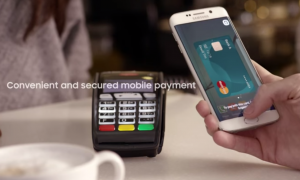Clash of titans – Android Pay vs Apple Pay vs Samsung Pay
We can regularly read about further dynamic growth in mobile payments both in Poland and around the world. It comes as no surprise that the biggest players in the technology market have long been sharpening their teeth for their piece of this lucrative pie. In the near future, we can expect particularly intense activity from Apple, Google and Samsung, who have already made their solutions available. Effect? Interesting, but unfortunately strongly unavailable for our country.
Android Pay, Apple Pay and Samsung Pay are competing against each other, presenting mobile payment systems that are quite similar in their operation. Each uses a mechanism to plug in a payment card and NFC technology. Samsung definitely stands out from the competition thanks to the MST technology, i.e. Magnetic Secure Transmission, which additionally enables payments also in terminals that do not support contactless payments. In this situation, the phone, in a way, simulates the scheme of card swiping with the help of a variable magnetic field mechanism. This solution definitely improves the possible range of payments – especially in countries with less availability of new terminals. The rest of the elements of all systems is very similar – you put the phone to the device and confirm the payment (PIN or fingerprint) to complete the transaction.
Before I move on to the less characteristic areas of each system, I would like to present you with the more frequently overlooked information that is what disqualifies each platform – at least in Poland.
The greatest chance for popularization in our country has the technology from Google. This is mainly due to the requirements for the phone – a model running on Android 4 is enough.4 or higher supporting HCE (Host Card Emulation) technology. This gives definitely more room for manoeuvre than Samsung's technology supported by the S6, S6 Edge, Galaxy Note 5 and S6 Edge+ models or Apple with its Watch (possibly in combination with the iPhone’s 5 series) and the iPhone 6 and 6s in both versions. Unfortunately, the price of these phones is still beyond the reach of the ordinary user, so Android Pay has potentially the biggest reach in our market. Admittedly, a lot of people still use older versions of Android, but newer versions of the system are now installed on lower-end models as well.
Even if you have the right equipment, the biggest problems are yet to come. According to foreign reports, Samsung cooperates only with American editions of its phones. Another problem also turned out to be a GSM operator issue in the US – Samsung's service cannot be used by m.In. Verizon subscribers. Once we get past this obstacle, we can "only" connect the appropriate card – and this is where the dog is buried for all available technologies.
As a citizen of the United States I would probably have no problem with obtaining a U.S. payment card. From the perspective of a Pole, however, this is already a breakneck task. If someone makes an effort and gets such a card, then he will be able to use Apple Pay in our country in some terminals. The number of banks supported by Samsung and Google is definitely shorter (especially in the case of the Mountain View concern) and puts a serious question mark on the further development of the systems.
A very interesting fact is the repeated reports about the problem with the availability of contactless terminals for Apple Pay and Android Pay in major markets. In Poland, the vast majority of devices allow this form of payment for purchases, but in the West, older devices still dominate, effectively slowing down the pace of implementation of new payment methods. If Samsung Pay were available to a wider range of devices and more banks, MST's technology would offer a clear advantage in this area. On the domestic market contactless transactions are not a problem so the main obstacle is the lack of cooperation with banks operating in Poland. Given the companies' past policy of working with local partners, this may take some time at best. What's more Apple still can't boast of such a share in our market as it obtains in other parts of the world.
So who wins in this battle? The biggest chance has Google
Efficient, convenient and secure payment is not yet available for any of the systems, and as long as no direct cooperation with Polish financial institutions is established, nothing is likely to change.
A much more interesting duel in global terms. On the one hand in western markets iPhones’y have a much larger market share and many more people can afford flagship phones. On the other hand MST technology is a powerful asset for Samsung. The success will be determined mainly by marketing, technological and economic opportunities in individual markets, as well as efficient partnerships with banks. Duel of the most famous giants does not mean, however, that the competition is limited only to the 3 biggest players on the market. On the horizon we can already see other companies trying to take over the service of mobile transactions. It promises to be an interesting clash of several different business models.
And at the end a handful of additional information related to the topic. Google's existing payment solution Google Wallet for transactions in stationary stores is replaced by Android Pay. On the other hand, online shopping and transferring funds to users will be possible with the new version of Google Wallet service.
MST technology from Samsung is a very effective solution, but it will not allow payment in those devices that "swallow" cards – e.g. On the other hand, online shopping and the transfer of money to the customer's bank account is not possible.


